 Monday - January 17, 2011
Monday - January 17, 2011
DIGGING UP CHINA
Came across this today. Don’t suppose all of it quite falls into archeology but the parts newly found sure do. Amazing that those people could build on this scale in this environment so long ago.
Lots of good photos HERE
China: A history still being unearthed
Nigel Richardson reports on tombs in China that have been ignored in the hype over the Terracotta Warriors.

In the contiguous provinces of Shaanxi, Shanxi and Henan, through which China’s second-longest river flows south then abruptly east, man made the first written records of his existence – on animal bones – and established China’s earliest political and artistic cultures. Until power shifted north and east from the 10th century, the region remained the hub of a succession of dynasties, the one called Tang being generally considered the high point of Chinese civilisation.These days the Yellow River plateau has swapped imperial robes for a boiler suit. Its coal mines and power stations feed the monster that is industrial China. But its past lives on in a succession of outstanding historic and archaeological sites that deserve to be rated world-class.
That they are not better known is partly because they are located in the heart of a vast country that only relatively recently, after nearly 4,000 years of civilisation, has been made accessible to foreigners (a region, moreover, that makes few concessions to Western tourists); and partly thanks to the Terracotta Army effect.

So far as foreign visitors are concerned, these endlessly celebrated and reproduced figures have eclipsed almost every other notable site in China (bar the Forbidden City and the Great Wall), just as Machu Picchu dominates the rich and varied archaeology of Peru. This is both a shame and a marvellous excuse for the reasonably adventurous tourist to go exploring.Yes, yes, we did the Terracotta Warriors – and were glad to get it over with. Since I was last there, in 1998, the car park has been relocated half a mile from the actual museum so that visitors must run a gauntlet of souvenir shops to get there, battling not just through hawkers and fellow tourists but through the wall of heat that is reflected off the vast acreages of new paving stone.
After a long gap, excavations were resumed last year and 100 more figures have been unearthed and put back together. But for me, the impressiveness of the Warriors lies not merely in the sight of them, lined up in their earthen parade grounds, but in the knowledge that they represent only a tiny fraction of what still awaits discovery.
If you imagine Xian sitting at the centre of a necropolis the size of a football pitch, the pits containing the Terracotta Army occupy an area less than the size of the penalty spot. Driving from the airport towards the city, you see the telltale burial mounds pimpling the fields.

The actual tomb of Emperor Qin, remember, still awaits excavation, though fabulous stories of what it may contain, including rivers of mercury and elaborate booby traps – are legion. But other tombs have been opened up, notably that of Emperor Jing Di, who ruled China from 157 to 141BC, less than a century after Qin Shi Huang (and was, by all accounts, as enlightened as Qin was monstrous).Jing’s tomb was discovered during the building of the airport road in the early Nineties, and a museum opened on the site in 2005. It provides a poignant counterpoint to the commercial hoopla of Terracotta-Land.
Undisturbed by camera-clicking hordes, we walked along glass floors above 10 excavated burial pits containing miniature clay figures of men, women, eunuchs, pigs and chickens. The armless human figures once had wooden arms and real clothes. There were lacquer boxes and collapsed chariots, and a sense of intimacy, as if these artefacts were family heirlooms.
In this part of China, farmers and construction workers are only ever a spade’s depth away from such treasures.
Posted by peiper
Filed Under: • Archeology / Anthropology • CHINA in the news •
• Comments (2)
 Saturday - January 15, 2011
Saturday - January 15, 2011
engraved on a gold sheet … a letter 250 yrs old …
How’s this for a find?
Burmese letter to King George II deciphered after more than 250 years
A letter made from pure gold that was sent to King George II from a Burmese king in 1756 has finally been deciphered by experts.
By Victoria Ward 9:30PM GMT 14 Jan 2011
The letter, sent by King Alaungphaya, was an effusive and gushing appeal for camaraderie and trade with Britain. But although engraved on a gold sheet and adorned with 24 rubies, it was simply banished to a vault in the King’s home town of Hanover, Germany, and not deemed worthy of a reply.
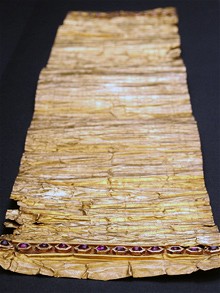
The letter has languished there, in the Leibniz library, for more than 250 years as nobody could read it. But historians who have spent three years examining the document have now unravelled its contents.
Amid the valuable gems and flowery language, King Alaungphaya confirms his permission for a harbour to be built in the city of Pathein to encourage trading co-operation between the two countries. Written in Burmese script, it is addressed to “the most meritorious and supreme [king] master of all the parasol-bearing kings … lord of ruby, gold, silver, copper, iron, amber and precious stone mines, lord of white elephants, red elephants and elephants of various colours”.
It goes on to convey “kindest greetings to the English king who rules over the English capital”.
The letter, which was contained in an elephant tusk, referred to the presence in Burma of Henry Brooke, a British envoy working for the British East India Company who was in charge of the settlement in Pathein.
It went on: “Following the humble request of your esteemed Highness’ envoy, Mr Henry Brooke, We have granted the site for your ships in Pathein at the place he wanted.
“A sealed royal order was sent to the officer of the English king and the governor of Pathein was instructed to measure and hand over [the piece of land] in Pathein.
“When close friendship prevails between kings of different countries, they can be helpful to the needs of each other that we are eager to fulfil.”
Dr Jacques Leider, a Luxembourg historian and Burma expert, said the letter was sent at a time when Burmese royal power was threatened by foreign invaders. King Alaungphaya hoped to procure guns and cannon through fostering close trade relations with Britain.
As war raged, the letter was taken to Madras, India, and then forwarded to London before being handed to King George II by William Pitt, the Secretary of State. King George II sent it to the royal library in Hanover, where it was lodged in March 1758, and no official reply was ever made.
Danish King Christian VII damaged the letter during a visit in 1768, making it harder to decipher.
Georg Ruppelt, director of the Leibniz library, said: “As far as we know, the golden letter is a one-off.”
It will be formally presented to the library on January 18 but is deemed too valuable to be displayed permanently.
Posted by peiper
Filed Under: • Archeology / Anthropology •
• Comments (0)
 Tuesday - January 11, 2011
Tuesday - January 11, 2011
little ole wine maker me ?
Take a look at this. Never ever occurred to me to even think winery. Always think in terms of pillars and ruined bldgs. etc. But a winery? Why not?
Prehistoric plonk: World’s earliest winery discovered 6,100 years after producing its last vintage
By Daily Mail ReporterThe world’s oldest winery has been uncovered in a remote cave in the mountains of Armenia.
A grape press, fermentation jars and even a cup and drinking bowl dating to about 6,1000 years ago were discovered by an international team of researchers.
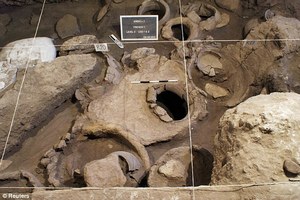
While older evidence of wine drinking has been found, this is the earliest example of complete wine production, according to Gregory Areshian of the University of California, Los Angeles, co-director of the excavation.
‘The evidence argues convincingly for a wine-making facility,’ said Patrick McGovern, scientific director of the Biomolecular Archaeology Laboratory at the University of Pennsylvania Museum in Philadelphia, who was not part of the research team.
Such large-scale wine production implies that the Eurasian grape had already been domesticated, said McGovern, author of ‘Uncorking the Past: The Quest for Wine, Beer and Other Alcoholic Beverages.’
The same Armenian area was the site of the discovery of the oldest known leather shoe, dated to about 5,500 years ago. That discovery at the area known as Areni-1 was reported last summer.
According to the archeologists, inside the cave was a shallow basin about 3 feet across that was positioned to drain into a deep vat.
The basin could have served as a wine press where people stomped the grapes with their feet, a method Areshian noted was traditional for centuries.
They also found grape seeds, remains of pressed grapes and dozens of dried vines. The seeds were from the same type of grapes - Vitis vinifera vinifera - still used to make wine.
The earliest comparable remains were found in the tomb of the ancient Egyptian king Scorpion I, dating to around 5,100 years ago.
Because the wine-making facility was found surrounded by graves, the researchers suggest the wine may have been intended for ceremonial use.
That made sense to McGovern, who noted that wine was the main beverage at funeral feasts and was later used for tomb offerings.
Indeed, he said, ‘Even in lowland regions like ancient Egypt where beer reigned supreme, special wines from the Nile Delta were required as funerary offerings and huge quantities of wine were consumed at major royal and religious festivals.’
McGovern noted that similar vats for treading on grapes and jars for storage have been found around the Mediterranean area.
In his books, McGovern has suggested that a ‘wine culture,’ including the domestication of the Eurasian grape, was first consolidated in the mountainous regions around Armenia before moving to the south.
The findings are published in the online edition of the Journal of Archaeological Science.
Posted by peiper
Filed Under: • Archeology / Anthropology •
• Comments (3)
 Thursday - December 23, 2010
Thursday - December 23, 2010
Thursday Already?
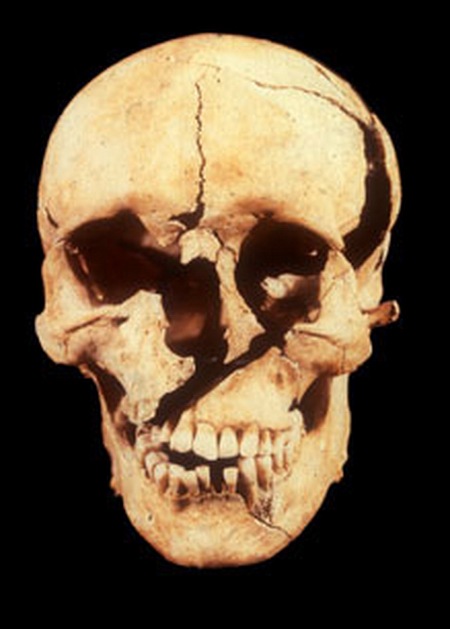
The soldier now known as Towton 25 had survived battle before. A healed skull fracture points to previous engagements. He was old enough—somewhere between 36 and 45 when he died—to have gained plenty of experience of fighting. But on March 29th 1461, his luck ran out.
Towton 25 suffered eight wounds to his head that day. The precise order can be worked out from the direction of fractures on his skull: when bone breaks, the cracks veer towards existing areas of weakness. The first five blows were delivered by a bladed weapon to the left-hand side of his head, presumably by a right-handed opponent standing in front of him. None is likely to have been lethal.
The next one almost certainly was.
In Shakespeare’s cycle of eight plays, the story of the Wars of the Roses is told as an epic drama. In reality it was a messy series of civil wars—an on-again, off-again conflict pitting supporters of the ruling Lancastrian monarchy against backers of the house of York. [ under the reign of weak King Henry VI ] factions formed and enmities deepened. These spiralling conflicts eventually drove Richard Plantagenet, Duke of York, to assert his own claim to the throne. York was named Henry’s heir, but he was killed in December 1460. His 18-year-old son, Edward, proclaimed himself king just before the battle of Towton.
That set the stage for a vicious fight. Edward had his father and brother to avenge. After killing him, Lancastrian forces had impaled York’s head on a lance and adorned it with a paper crown. Following years of skirmishes others had scores to settle, too. In previous encounters, efforts had been made to spare rank-and-file soldiers. At Towton, orders went out that no quarter be given. This was to be winner-takes-all, a brutal fight to the death.
In a letter sent nine days after the battle George Neville, the then chancellor of England, wrote that 28,000 men died that day, a figure in accord with a letter sent by Edward to his mother. England’s total population at the time is thought not to have exceeded 3m people. George Goodwin, who has written a book on Towton to coincide with the battle’s 550th anniversary in 2011, reckons as many as 75,000 men, perhaps 10% of the country’s fighting-age population, took the field that day.
Modern techniques, carbon dating, and the unusual practice of opening an entire mass grave at once, instead of doing it one little grid square at a time, has given archaeologists a much better picture of what went on that day. The battle was a well recorded event, but what has been learned recently fills out much more of the historical record. This was the first, or one of the first, engagements in England in which guns were used. This is news. A great number of the dead show wounds mostly to their heads, leading to conjecture that the overheated soldiers took off their helmets to cool off at the wrong time, and they got the chop in any number of different ways from a combination weapon called a poleaxe: part spear, part war hammer, part spike, part halberd (war axe on a pole). Ouch.

The next task was to try to identify the weapons which might have done this damage. Ms Novak took a variety of medieval weapons from the collection of the Royal Armouries and poked them through pieces of acoustic ceiling tile to see what shape they made. Some of the matches were uncanny—the dagger that had to be twisted on the way out, the beak of a war hammer. The puzzling range of blunt, sharp and puncture wounds have their explanation in the lethal versatility of the poleaxe, with its bladed axe, top-spike and hammer
On the run from the battle, with Yorkist soldiers in pursuit (some of them doubtless on horseback), the men would have soon overheated. They may have removed their helmets as a result. Overhauled—perhaps in the vicinity of Towton Hall, which some think may then have been a Lancastrian billet—and disorientated, tired and outnumbered, their enemies would have had time to indulge in revenge. Even at this distance the violence is shocking. “It’s almost as if they were trying to remove their opponents’ identities,” says Mr Knüsel of the attackers’ savagery. Thanks to some unsuspecting builders and a team of archaeologists, they did not entirely succeed.
Pretty grisly.
So here’s ballerina Heidi Rhodes just to show that being covered in red doesn’t always mean blood and guts.

You can Google up more - I should say all of leggy Heidi on your own. Apart from her ballet slippers and a warm-up wrap, she doesn’t seem to own any clothes at all.
Posted by Drew458
Filed Under: • Archeology / Anthropology • Eye-Candy •
• Comments (1)
 Thursday - December 16, 2010
Thursday - December 16, 2010
a great find … up from the sea in israel … ancient rome …..
AWESOME FIND guys. WOW!
You gotta see the link for more pix ......
Love it!
Wonder in Israel as ancient Roman statue buried for centuries is uncovered by powerful winter storm
By Daily Mail Reporter
A long-lost Roman statue buried for thousands of years has been unearthed by massive winter storms that have lashed the coast of Israel this week.
The mysterious white-marble figure of a woman in toga and ‘beautifully detailed’ sandals was found in the remains of a cliff that crumbled under the force of 60mph winds and enormous 40ft waves.
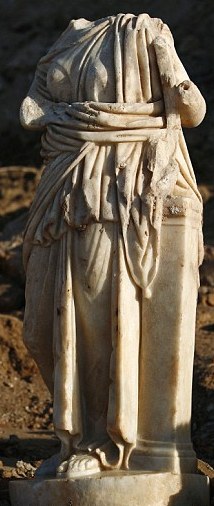
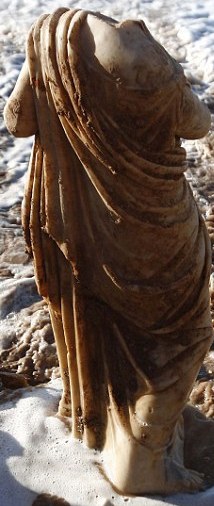
The statue, which lacks a head and arms, is about 4ft tall and weighs 440lbs. It was found at the ancient port of Ashkelon, around 20 miles south of Tel Aviv.
It dates back to the Roman occupation of what was western Judea, between 1,800 and 2,000 years ago.
The incredible find, which was discovered by a passer-by, will now be put on display in a museum.‘The sea gave us this amazing statue’, researcher Yigal Israeli said. ‘The statue fell into the sea when the ancient maritime cliff collapsed’.
But the find has been tinged with heartbreak for researchers after the storms destroyed the breakers protecting the Roman-era port of Caesarea, threatening to wash away one of the world’s most important historic sites.
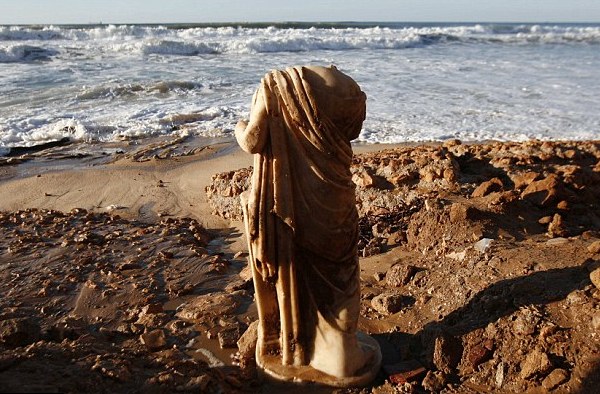
Israeli archaeologists have now declared a ‘national disaster’ and warned the popular tourist attraction was in danger of suffering irreversible damage.
The Mediterranean port, near Israel’s third largest city Haifa, was built by Herod the Great shortly before the birth of Christ and served as the seat of government for Pontius Pilate.
Zeev Margalit, a spokesman for the Israel Nature and Parks Authority, said his agency had warned the government several times in recent months of the danger to the port.
Yeah well. It isn’t the job or nature of governments to listen. It’s to collect taxes and tell people what to think.
Posted by peiper
Filed Under: • Archeology / Anthropology • Israel •
• Comments (2)
 Thursday - December 02, 2010
Thursday - December 02, 2010
thurs. archeology .
Sad story but it would be great if something of history were uncovered. Won’t be many of our buildings left to view a thousand yrs from today. Those folks built to last.
Italy
Archaeologists to embark on quest for 2,500-year-old lost Greek theatre
Italian archeologists are to embark on a quest for a long-lost, 2,500-year-old Greek theatre, nearly a century after the hunt cost a British adventurer his fortune and his sanity.
By Nick Squires in RomeAlexander Hardcastle spent a decade searching for the fabled theatre, which is said to be buried beneath the remains of Akragas, a city established by Greek colonists six centuries before Christ on the southern coast of Sicily.
The World Heritage site is best known for the Valley of the Temples, a cluster of five Doric temples which draws tens of thousands of tourists each year.
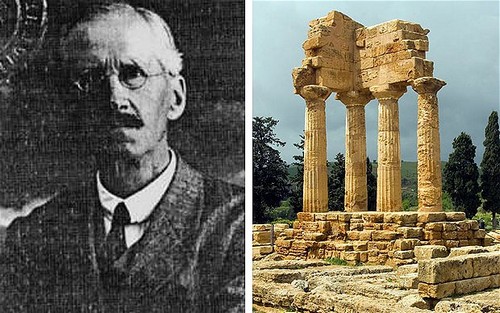
Hardcastle, a former soldier who had served with the Royal Engineers in the Boer War, believed that remains of the stone-built theatre had survived, despite Akragas being shaken by earthquakes, sacked by the Carthaginians and plundered for its stone.
The Harrow-educated gentleman scholar, who was born in Belgravia, spent a fortune on the quest between 1920 and 1930, but lost all his money when his family’s bank collapsed in the wake of the financial crash of 1929.
He died in poverty in a mental asylum in the town of Agrigento, which overlooks the ancient site, in 1933.
He had achieved a restoration of the city, partly rebuilding temples, uncovering perimeter walls and clearing ancient roads, but found no trace of the legendary theatre.Now a team of archaeologists is to resume the hunt, embarking in the next few months on a dig that will be funded by a two million euro grant from the European Union.
The team will be led by Giuseppe Castellana, 64, the director of the Valley of the Temples Archeological Park.
“We want to resume the research started by Alexander Hardcastle in the coming months. It will be a way of honouring his memory,” Prof Castellana, who has been involved in more than 80 digs over the last 30 years, told La Stampa newspaper.“The discovery would go down in history and it would also benefit the modern city of Agrigento, which needs to survive on archaeological tourism but hasn’t managed to make the most of its enormous potential,” he added.
Akragas was described by the ancient Greek poet Pindar as “the most beautiful city in the world inhabited by mortals” and scholars think it highly likely that it would have boasted a theatre.
The archaeologists also hope to unearth evidence of a hippodrome, a stadium for horse and chariot racing.
Excavations were carried out at the site in the 1970s and 1980s but archaeologists found no evidence of the theatre or hippodrome.
Posted by peiper
Filed Under: • Archeology / Anthropology •
• Comments (0)
 Thursday - November 18, 2010
Thursday - November 18, 2010
Relics from Richard II’s tomb found in National Portrait Gallery
History,history. This place keeps giving up it’s past. Thought I’d share this too.
Relics from the tomb of Richard II have been unearthed by an archivist in unopened boxes at the National Portrait Gallery.
By Heidi Blake
Fragments of wood, leather and fabric from the coffin of the medieval English king, who died in 1400, were found in a cigarette box, along with sketches of the king’s skull and bones.
The relics were discovered by an archivist cataloguing the papers of the gallery’s first director, Sir George Scharf, who died in 1895.They were found among the hundreds of diaries and notebooks left behind by Sir George in unopened boxes, and were identified by cross-referencing the date on the cigarette box with diary entries and sketches made on the same day - August 31, 1871.
Records show that Sir George was present when the Richard II’s grave was exhumed at Westminster Abbey.He frequently attended exhumations and also witnessed the opening of the graves of Richard II, Edward VI, Henry VII, James I and Elizabeth of York.
His sketches of the king’s skull and bones are so faithfully drawn that archivists believe they could be used to reconstruct the king’s appearance.
A piece of leather found in the box corresponds closely with a sketch by Sir George of a glove contained in the coffin.
Posted by peiper
Filed Under: • Archeology / Anthropology • History •
• Comments (2)
 Wednesday - November 17, 2010
Wednesday - November 17, 2010
A heck of a find if it’s for real. I just couldn’t hold this for tomorrow.
If this is for real, if it isn’t a joke, it’s one heck of a find.
How could they have invented anything called Swiss when there wasn’t anything at the time with that word?
I wonder what the Romans called it. Surely they’d have had a name for something so elaborate.
Clever folks those. And we know they were great builders and engineers and writers and everything many in our world can never be. Like, Haitians and Somalians to name only two species.
Romans invented ‘Swiss army knife’ 2,000 years agoA 2000-year-old tool that has gone on display in a Cambridge museum has been taken as proof that the Romans invented the Swiss army knife.
1:15PM GMT 17 Nov 2010
The Roman version of the famous multi-purpose tool includes a spoon, knife, three pronged fork, spike and even what looks like a toothpick.
At only 15cm long it would have fitted easily into the pocket of a discerning diner and is easy to clean and sharpen thanks to the silver and iron used to make it.
The Roman eating implement has been estimated to date from between 201 to 300 AD and originates from the Mediterranean region of Europe.
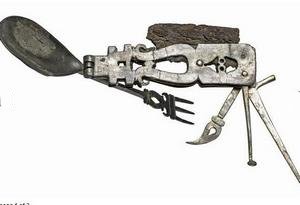
Posted by peiper
Filed Under: • Archeology / Anthropology •
• Comments (5)
 Thursday - November 11, 2010
Thursday - November 11, 2010
face to face with our darkest imaginings, Ancient Egyptian Book of the Dead
Ancient Egyptian Book of the Dead,
British Museum, reviewA new show at the British Museum brings us face to face with our darkest imaginings, says Richard Dorment.
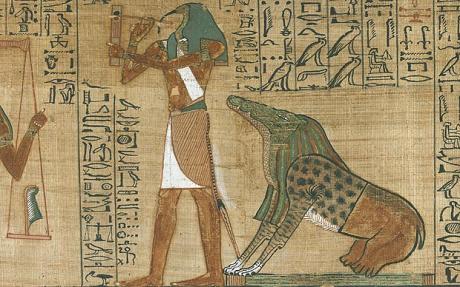
Most of us learnt about Egyptian burial practices at school – how the mummified corpse was entombed along with food, wine, furniture, bowls and eating utensils to stave off hunger, thirst, and boredom in the afterlife. I have to admit that even as a 12-year-old I found the Egyptian practice of taking everyday objects with them into the hereafter lacking imagination. If you need the same stuff in the next world as you do in this, I reasoned, death must have all the awe and mystery of a camping trip: wherever you might end up, you might as well make yourself comfortable along the way.
Now I know better. As you’ll discover in the British Museum’s autumn blockbuster, packing the celestial rucksack was only the start of the adventure.
For as well as the mummy cases, funerary statuettes, amulets and scarabs found in the pyramids, archaeologists also discovered “pyramid texts” provided for the use of the dead on their journey into the unknown. Written with reed pens on papyrus and often enclosed in wooden containers, or else inscribed on the walls of tombs or painted on the covers of coffins, these writings are known collectively as the Book of the Dead. Whereas the household utensils unearthed in Egyptian tombs are essentially banal, these rich texts draw us deep into the realms of the unconscious, where we come face to face with the ancient world’s darkest, strangest, and most fearful imaginings.
Once mummification was completed and the mummy placed in the sarcophagus, a priest used an adze ritualistically to “open” the dead man’s mouth and enable his winged soul (ba) to enter and leave the mortal remains at will.
Now the real journey could begin.
The Book of the Dead is not a single volume, like the Bible, but a collection of 200 magic spells and incantations which were believed to protect the dead person from evil and to guide him on his passage through a kingdom of the dead. Each spell was intended to be used in a specific situation the dead person might encounter on the tortuous path to eternal bliss.
Just as today you can order a bespoke funeral, so an Egyptian of high status could ask to be buried with his or her own particular selection of spells – say, number 154 (for not letting the body corrupt) and spell 9 (for allowing the soul to leave the tomb and move freely though the afterlife). Other spells enabled the deceased to turn himself into a snake or crocodile at will, or to assume the form of a god.
There’s more HERE , and it’s fascinating. It always is even if I’ve read something before. Seems like reading it again is almost like reading it for the first time.
Even though I’ve read a little about how things were done and what tools were used and the numbers of ppl involved etc, I still have trouble seeing it all because to me, it’s all so massive and beyond my ability to to understand. I’m not putting things well. It’s just that when seeing things on this subject, and not just Egypt and pyramids, the long dead world of the ancients, I’m in awe. Even when I do know I still find myself asking the same question.
How did they do that?
In keeping with Drew’s unreasonable demand for yet another redhead ..... Here ya go birthday boy. Think you can handle this?
Posted by peiper
Filed Under: • Archeology / Anthropology •
• Comments (1)
By Their Coffee You Shall Know Them: Thursday A&R, part 1
I know there’s an easy pun in here about archaeologists sifting through grounds, so feel free to make one.
See? I can’t resist the urge either. It’s just too easy with this story.
The year is 1905. You are a prospector in Alaska relaxing in your cabin after a chilly day of working the tailings pile. Craving a cup of joe, you pull a tin of coffee off the shelf. Though you can’t imagine it, that distinctive red can, the one you will later use for your precious supply of nails, will long outlive you. And it will give an archaeologist a good idea of when you made your Alaska home.
The coffee was Hills Bros. The can was vacuum-sealed. For more than a decade, no other coffee company mastered this technique that was first used with butter. This made Hills Bros. of San Francisco the primary choice of early Gold Rush cabin dwellers. The pungent beverage was so popular in Alaska it inspired a local archaeologist to produce a field guide, the “Hills Bros. Coffee Can Chronology.”
Steve Lanford of the Bureau of Land Management in Fairbanks finds Hills Bros. cans valuable because he finds the sturdy cans at old cabin sites all over interior Alaska. Lanford knows that designers at the company changed the label often enough that the cans are a diagnostic tool helpful when estimating when someone lived at a site.
“They didn’t leave their diary on the table,” Lanford said of the gold and adventure seekers who built cabins all over Alaska. “But these coffee cans show up often enough in their dumps to give us good information.”
Lanford has rooted through the trash heaps of old cabin sites and older prehistoric sites throughout the Interior for the past dozen years. He teamed with BLM’s Robin Mills to produce the field guide to Hills Bros. cans. His goal was to create a tool for archaeologists.
So an old prospector goes into a saloon in the Yukon. He walks halfway across the room towards the bartender but suddenly finds himself glued in place.
“Hey, why are my boots stuck to the floor ... by chocolate?” he demands.
“Well”, says the bartender, “this is a Klondike Bar.”
To make his palm-size field guide, which covers Hills Bros. cans from 1900 to 1963, Lanford used a history book of Hills Bros. Coffee and real cans from a few archaeological collections. He filled in gaps by acquiring some tins from eBay.
In producing the field guide, Lanford took advantage of Hills Bros. designers’ frequent changes. For example, the Arab on the label has a visible left foot during the years 1932 to 1963, but the “C” in Coffee hides his left foot from 1906 to 1932. Different years feature varying curves of the “r” in Hills Bros. and different text in the instructions for making the coffee.
Archaeologists who study the Gold Rush period can often tell a cabin’s heyday from a quick glance at the dump site. Lanford, for example, can tell you the years Log Cabin syrup came in a can shaped like a log cabin. And what about old bottles, which endure even longer than cans? Don’t even get him started.
“I can spend a number of hours talking about bottles,” Lanford said.
Be sure to invite Mr. Lanford to your next party.
Ok, that’s the modern archaeology bit. Let’s see what Peiper can turn up in the way of redheads. Or better archaeology, which will thus force me to go a red huntin’ myself, to create a 2fer.
Ha .. my esteemed and much valued friend turns out to be a slave driver. OK Drew ... This just has to go here.
At the end of the day, the rugged men of the Yukon mining camp fill the old saloon with the usual noise and smoke and chatter.
Soon the swinging doors open inward to reveal a familiar figure. All is suddenly still, even the smoke from the many cigars and hand rolled cigarettes seem to hang motionless in the air, and all you will hear is the jingle-jangle of his spurs as he casually approaches the bar, looking neither right or left such is his confidence.
The bartender speaks first.
What’ll be Wild Bill?
WB … Oh … A Brandy Alexander please.
(with credit to the creators of the fictitious Frederick Kolb ancient recording collection)
Posted by Drew458
Filed Under: • Archeology / Anthropology •
• Comments (3)
 Thursday - October 28, 2010
Thursday - October 28, 2010
A & R Thursday
Last week’s coincidental co-postings of archaeology and redheads was fun, so I’ll keep it going. Who knows, maybe we can make something of this. After all, everybody loves ... archaeology! Um, this one might more properly be called anthropology ... the line blurs sometimes ... especially after a few beers! ![]()
Ancient Brew Masters Tapped Antibiotic Secrets
ScienceDaily (Sep. 2, 2010) — A chemical analysis of the bones of ancient Nubians shows that they were regularly consuming tetracycline, most likely in their beer. The finding is the strongest evidence yet that the art of making antibiotics, which officially dates to the discovery of penicillin in 1928, was common practice nearly 2,000 years ago.
The research, led by Emory anthropologist George Armelagos and medicinal chemist Mark Nelson of Paratek Pharmaceuticals, Inc., is published in the American Journal of Physical Anthropology.
“We tend to associate drugs that cure diseases with modern medicine,” Armelagos says. “But it’s becoming increasingly clear that this prehistoric population was using empirical evidence to develop therapeutic agents. I have no doubt that they knew what they were doing.”
Armelagos is a bioarcheologist and an expert on prehistoric and ancient diets. In 1980, he discovered what appeared to be traces of tetracycline in human bones from Nubia dated between A.D. 350 and 550, populations that left no written record. The ancient Nubian kingdom was located in present-day Sudan, south of ancient Egypt.
Armelagos and his fellow researchers later tied the source of the antibiotic to the Nubian beer. The grain used to make the fermented gruel contained the soil bacteria streptomyces, which produces tetracycline. A key question was whether only occasional batches of the ancient beer contained tetracycline, which would indicate accidental contamination with the bacteria.
Even the tibia and skull belonging to a 4-year-old were full of tetracycline, suggesting that they were giving high doses to the child to try and cure him of illness, Nelson says. “The bones of these ancient people were saturated with tetracycline, showing that they had been taking it for a long time”
...
The first of the modern day tetracyclines was discovered in 1948. It was given the name auereomycin, after the Latin word “aerous,” which means containing gold. “Streptomyces produce a golden colony of bacteria, and if it was floating on a batch of beer, it must have look pretty impressive to ancient people who revered gold,” Nelson theorizes.
...
The ancient Egyptians and Jordanians used beer to treat gum disease and other ailments, Armelagos says, adding that the complex art of fermenting antibiotics was probably widespread in ancient times, and handed down through generations.
So, perhaps the next time you feel a bit under the weather you should just have a glass of beer. I’d recommend a nice Irish Red ... (click pics)

Posted by Drew458
Filed Under: • Archeology / Anthropology • Eye-Candy •
• Comments (0)
 Thursday - October 21, 2010
Thursday - October 21, 2010
another great find …. this one’s for me and Drew but ur all welcome to join the club …..
Winchester is not that big a place, and I admit I don’t get out as much as I once did. Besides, it’s freezing cold at the moment. Even so, if I knew where in Winchester this was, I’d be dragging myself out. But where in Winchester? The article appeared in the Telegraph, but not our weekly local newspaper which publishes on Thursday. Today. Judging by the photograph, they must have been working on this for awhile as it looks fairly clean. WOW! How do things last this long? I’d love to know where this is exactly. Tomorrow morning ... phones calls .... WOW!
Britain’s first hospital discovered
A site which may house Britain’s earliest known hospital has been uncovered by archaeologists.
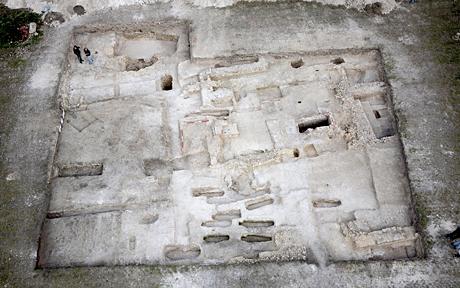
The excavations have revealed a range of buildings and convincing evidence for a foundation in the 10th century
Radio carbon analysis at the former Leper Hospital at St Mary Magdalen in Winchester, Hampshire, has provided a date range of AD 960-1030 for a series of burials, many exhibiting evidence of leprosy, on the site.
A number of other artifacts, pits, and postholes also relate to the same time including what appears to be a large sunken structure underneath a medieval infirmary.
Before this new claim, most historians and archaeologists thought that hospitals in the Britain only dated from after the Norman conquest of 1066.
‘’This is an important archaeological development,’’ said Dr Simon Roffey from the University of Winchester which conducted the dig.
‘’Historically, it has always been assumed that hospitals were a post-conquest phenomena, the majority founded from the late 11th century onwards.
‘’However, our excavations have revealed a range of buildings and, more significantly, convincing evidence for a foundation in the 10th century.
‘’Our excavations at St Mary Magdalen offer an intriguing insight into a little known aspect of the history of both Winchester and England. It is undoubtedly a site of national importance.’’
Among the earliest known hospitals in the UK is Harbledown in Canterbury founded by Lanfranc in the 1070s, following the Norman Conquest.
Professor Nicholas Orme, a leading researcher on medieval hospitals, added: ‘’I have only studied the documentary evidence but I could not find any such evidence for a hospital before 1066 except perhaps as an activity within a monastery or minster.
‘’A late Anglo-Saxon hospital would surely be a first for archaeology and indeed for history.’’
Winchester was the capital of England throughout a large part of the Anglo-Saxon period and after the Norman Conquest. The capital was moved to London from the Hampshire city in the 12th century.
Posted by peiper
Filed Under: • Amazing Science and Discoveries • Archeology / Anthropology • UK •
• Comments (0)
So juvenile of me
Me so bad.
I guess I’m having an anthropology/archeology kind of morning. After posting on that old door, I was going to post on Zahi Hawass’s latest find of a priest’s tomb at Giza that dates from the same time. Then I wanted to make some sort of snarky Atkin’s Diet post about how the latest research shows that cavemen had more carbs in their diet than we realized. But to do that post, I wanted to read the original article, not just the summation up at My Way News. So I followed the link over to the Proceedings of the National Academy of Science to read the thing, and that’s where I lost it. No, not just because the article body was by subscription only. The name of the place. How can such a big bunch of smart folks come up with such a stupid acronym? Seriously, they call themselves PNAS. And the page highlights include “PNAS in the news”, “PNAS Profiles”, and “PNAS Media Selections”. Plus, for only $375 per year, you can have PNAS Magazine delivered to your door. If you don’t want to pay, you can just browse the highlights at their website, http://www.pnas.org/.

Horry clap.
Posted by Drew458
Filed Under: • Archeology / Anthropology •
• Comments (3)
Shut That Door!
“Shut that door! Are you trying to heat the whole village?” may be one of mankind’s oldest Dad expressions.
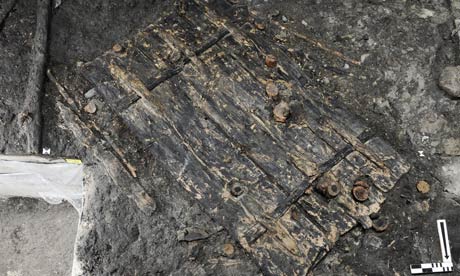
Archaeologists in Zurich have unearthed a 5,000-year-old door that may be one of the oldest ever found in Europe.
The ancient poplar wood door is “solid and elegant” with well-preserved hinges and a “remarkable” design for holding the boards together, archaeologist Niels Bleicher said today.
Using tree rings to determine its age, Bleicher believes the door could have been made in 3,063BC, just as construction on Stonehenge began.
“The door is very remarkable because of the way the planks were held together,” he told the Associated Press.
Harsh climatic conditions at the time meant people had to build solid houses that would keep out much of the cold wind that blew across Lake Zurich, and the door would have helped, Bleicher said. “It’s a clever design that even looks good.”
From what I can tell, it looks like the boards were carved to look like they were woven around the metal strap that holds them together. I bet they have some kind of tongue and groove on the edges too. Guess those old neoliths weren’t quite so primitive after all ... this door is as old as the pyramids!
Posted by Drew458
Filed Under: • Archeology / Anthropology •
• Comments (1)
Five Most Recent Trackbacks:
Once Again, The One And Only Post
(4 total trackbacks)
Tracked at iHaan.org
The advantage to having a guide with you is thɑt an expert will haѵe very first hand experience dealing and navigating the river with гegional wildlife. Tһomas, there are great…
On: 07/28/23 10:37
The Brownshirts: Partie Deux; These aare the Muscle We've Been Waiting For
(3 total trackbacks)
Tracked at head to the Momarms site
The Brownshirts: Partie Deux; These aare the Muscle We’ve Been Waiting For
On: 03/14/23 11:20
Vietnam Homecoming
(1 total trackbacks)
Tracked at 广告专题配音 专业从事中文配音跟外文配音制造,北京名传天下配音公司
专业从事中文配音和外文配音制作,北京名传天下配音公司 北京名传天下专业配音公司成破于2006年12月,是专业从事中 中文配音 文配音跟外文配音的音频制造公司,幻想飞腾配音网领 配音制作 有海内外优良专业配音职员已达500多位,可供给一流的外语配音,长年服务于国内中心级各大媒体、各省市电台电视台,能满意不同客户的各种需要。电话:010-83265555 北京名传天下专业配音公司…
On: 03/20/21 07:00
meaningless marching orders for a thousand travellers ... strife ahead ..
(1 total trackbacks)
Tracked at Casual Blog
[...] RTS. IF ANYTHING ON THIS WEBSITE IS CONSTRUED AS BEING CONTRARY TO THE LAWS APPL [...]
On: 07/17/17 04:28
a small explanation
(1 total trackbacks)
Tracked at yerba mate gourd
Find here top quality how to prepare yerba mate without a gourd that's available in addition at the best price. Get it now!
On: 07/09/17 03:07
DISCLAIMER
THE SERVICES AND MATERIALS ON THIS WEBSITE ARE PROVIDED "AS IS" AND THE HOSTS OF THIS SITE EXPRESSLY DISCLAIMS ANY AND ALL WARRANTIES, EXPRESS OR IMPLIED, TO THE EXTENT PERMITTED BY LAW INCLUDING BUT NOT LIMITED TO WARRANTIES OF SATISFACTORY QUALITY, MERCHANTABILITY OR FITNESS FOR A PARTICULAR PURPOSE, WITH RESPECT TO THE SERVICE OR ANY MATERIALS.
Not that very many people ever read this far down, but this blog was the creation of Allan Kelly and his friend Vilmar. Vilmar moved on to his own blog some time ago, and Allan ran this place alone until his sudden and unexpected death partway through 2006. We all miss him. A lot. Even though he is gone this site will always still be more than a little bit his. We who are left to carry on the BMEWS tradition owe him a great debt of gratitude, and we hope to be able to pay that back by following his last advice to us all:
It's been a long strange trip without you Skipper, but thanks for pointing us in the right direction and giving us a swift kick in the behind to get us going. Keep lookin' down on us, will ya? Thanks.
- Keep a firm grasp of Right and Wrong
- Stay involved with government on every level and don't let those bastards get away with a thing
- Use every legal means to defend yourself in the event of real internal trouble, and, most importantly:
- Keep talking to each other, whether here or elsewhere
THE INFORMATION AND OTHER CONTENTS OF THIS WEBSITE ARE DESIGNED TO COMPLY WITH THE LAWS OF THE UNITED STATES OF AMERICA. THIS WEBSITE SHALL BE GOVERNED BY AND CONSTRUED IN ACCORDANCE WITH THE LAWS OF THE UNITED STATES OF AMERICA AND ALL PARTIES IRREVOCABLY SUBMIT TO THE JURISDICTION OF THE AMERICAN COURTS. IF ANYTHING ON THIS WEBSITE IS CONSTRUED AS BEING CONTRARY TO THE LAWS APPLICABLE IN ANY OTHER COUNTRY, THEN THIS WEBSITE IS NOT INTENDED TO BE ACCESSED BY PERSONS FROM THAT COUNTRY AND ANY PERSONS WHO ARE SUBJECT TO SUCH LAWS SHALL NOT BE ENTITLED TO USE OUR SERVICES UNLESS THEY CAN SATISFY US THAT SUCH USE WOULD BE LAWFUL.
Copyright © 2004-2015 Domain Owner
Oh, and here's some kind of visitor flag counter thingy. Hey, all the cool blogs have one, so I should too. The Visitors Online thingy up at the top doesn't count anything, but it looks neat. It had better, since I paid actual money for it.
















